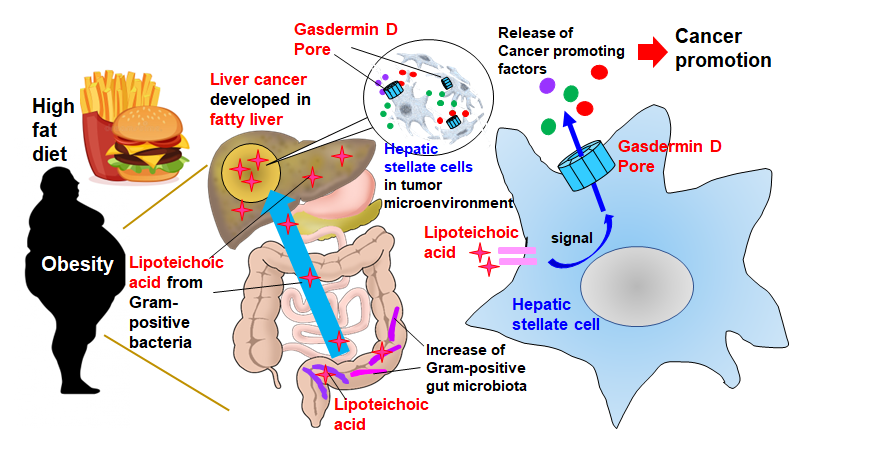Research News
Jun 25, 2022
Porous Cells Lead to Poorer Livers
The formation of cell membrane pores is a major mechanism by which cancer-inducing proteins are released and hasten tumor development in nonalcoholic steatohepatitis-associated liver cancer.
Osaka, Japan – Need another reason to think twice before ordering that extra helping of fries? It could lead to a higher risk of developing liver cancer. Cases of nonalcoholic steatohepatitis (NASH) – a type of fatty liver disease that might also lead to cancer – are on the rise, and treatment remains elusive. A research group led by Osaka Metropolitan University took a potential step toward suppression and treatment of NASH-associated liver cancer with their research using obese mice that explains the importance of secreted proteins from cell membrane pores formed in cells in the vicinity of cancer cells in the tumor microenvironment for cancer development. Their findings were published in “Science Immunology.”
High-fat diets weaken gut barrier function, resulting in the migration and accumulation of lipoteichoic acid in the liver. The accumulated lipoteichoic acid stimulates the cleavage of gasdermin D protein, forming cell membrane pores where the SASP factors IL-1β and IL-33 are released from hepatic stellate cells. IL-33 activates regulatory T cells that suppress immune response, accelerating cancer development.

While cancer cells themselves are obviously detrimental, neighboring cells including cancer-associated fibroblasts in a so-called “tumor microenvironment” can play a part in cancer development as well. “In the obesity-associated liver tumor microenvironment, the fibroblasts called ‘hepatic stellate cells’ become senescent,” explained lead researcher Professor Naoko Ohtani. “This causes them to exhibit a senescence-associated secretory phenotype (SASP), where they release a set of proteins that promote cancer by suppressing anti-tumor immunity.” The mechanism by which proteins such as SASP factors are released and accelerate tumor development remains unclear.
Professor Ohtani’s team attempted to uncover this mechanism by feeding a high-fat diet to cancer-prone mice and studying the obesity-induced liver cancer. They first conducted a comprehensive gene expression analysis to determine what SASP factors were produced by hepatic stellate cells and then investigated how they were released.
The SASP factors IL-1β and IL-33 were discovered to be two of the key facilitators of liver cancer growth. Their release occurs in two main stages. “First, the high-fat diet weakens gut barrier function, resulting in the migration and accumulation of lipoteichoic acid in the liver,” Professor Ohtani elaborated. “Second, the accumulated lipoteichoic acid stimulates the cleavage of gasdermin D protein. This, in turn, forms cell membrane pores where IL-1β and IL-33 are exported or released from hepatic stellate cells.”
These pores play a crucial role, because once IL-33 is released, it activates its receptor-positive regulatory T cells that act to suppress the immune response to cancer cells and potentially exacerbate cancer development.
Understanding this mechanism is an important advance in humanity’s battle against cancer. “Our study revealed a very interesting mechanism by which the tumor-promoting SASP factors are released through the cell membrane pores formed by the stimulation of gut microbial component,” concluded Professor Ohtani. “Inhibiting this pore formation may facilitate prevention and therapeutic strategies for NASH-associated liver cancer patients.”
Funding
This work was supported by AMED (Japan Agency for Medical Research and Development), AMED-CREST under grant number JP20gm1010009 (N.O.), AMED under grant number JP20fk0210050 (N.K.), JP19ck0106260 (N.O.), JP20cm0106401 (E.H.), JP20gm5010001 (E.H.) and Precursory Research for Embryonic Science and Technology (PRESTO) under grant number JPMJPR18H6 (S.N.) and Exploratory 766 Research for Advanced Technology (ERATO) under grant number JPMJER1902 (S.F.). This study was also supported by the Japan Society for the Promotion of Science (JSPS) under grant number 19H04002 (N.O.), 19H03641 (N.K.), 18H02847 (S.N), 21H02963(S.N.), 20K16121 (T.K.), 20K15695 (M.T.), 20K16309 (R.Y.), and Japan Science and Technology agency (JST), the establishment of university fellowships towards the creation of science technology innovation, under grant number JPMJFS 2138 (Y. N), as well as grants from Takeda Science Foundation (N.O. and F. K.) and Yakult Bio-Science Foundation (T.K. and N.O.) and Research Grant of the Princess Takamatsu Cancer Research Fund 18-25003 (N.O.).
Paper Information
Title: Gasdermin D-mediated release of IL-33 from senescent hepatic stellate cells promotes obesity-associated hepatocellular carcinoma
Journal: Science Immunology
DOI: 10.1126/sciimmunol.abl7209
Publication date: June 25, 2022
Contribution to SDGs

3: Good Health and Well-Being
Contact
Graduate School of Medicine
Prof. Naoko OHTANI
E-mail: naoko.ohtani[at]omu.ac.jp
*Please change [at] to @.
SDGs
